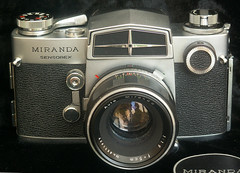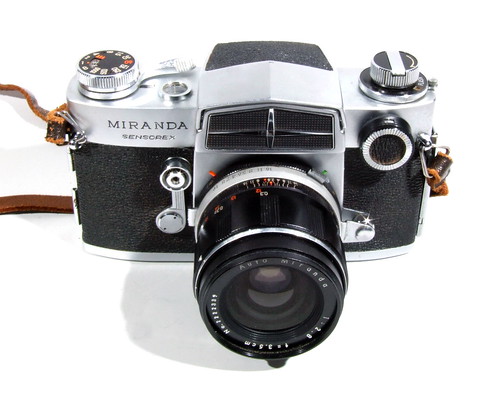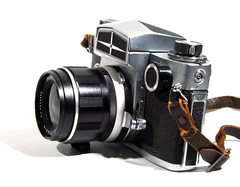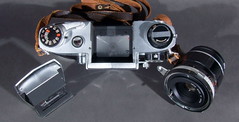
|
| Miranda Sensorex (1967) image by Pumpkinpies (Image rights) |
Miranda Sensorex is a 35 mm SLR system film camera manufactured by Miranda. There are seven almost-the-same but distinct versions of Sensorex.[1] There are two very peculiar features in Miranda: the interchangeable prism (the Nikon F and Topcon Super D were notable professional 35mm SLRs at the time with this feature), and the front-mounted shutter release. The camera also featured a low noise shutter and vibration-free mirror mechanism. After removing the pentaprism, the camera is fully functional and can still meter and focus, which is especially handy for close-up work. The Sensorex was the flagship model at that time. Miranda was apparently the first Japanese SLR manufacturer, and for a time, Miranda used to compete with Nikon and Topcon for build quality and optics. The Miranda was also sold as Soligor in Europe. The Miranda Camera Company, originally named the Orion Camera Company, manufactured cameras in Japan between 1955 and 1978. Their first camera was the Miranda T. Unlike many Japanese made cameras, Miranda did not make their own lenses and had to rely on other manufacturers to supply them. Many Miranda SLRs had advanced or sophisticated features for their day. Almost all Miranda SLR's shared the same basic lens mount, but the mount complexity increased over the years to accommodate more aperture and metering controls. Unable to keep up with the increasing manufacturing automation of the larger manufacturers, and the increasingly sophisticated electronics of competing cameras, Miranda ceased producing cameras. (Miranda and Soligor were owned by an American company AiC based in Brookland)
Types[]
Type data is according to [1]
| Type | First serial no. | Standard lens | Meter type | Max.aperture | Meter needle | Back hinge | Finish |
|---|---|---|---|---|---|---|---|
| 1 | 705xxx | 50/1.9 | spot | 1.9 | open "C" | removable | chrome |
| 2 | 717xxx | 50/1.9 | spot | 1.9 | closed circle | removable | chrome |
| 3 | 770xxx | 50/1.8, 50/1.4 | average | 1.8 | closed circle | removable | chrome |
| 4 | 900xxx | 50/1.8,50/1.4 | average | 1.8 | closed circle | removable | chrome |
| 5 | 900xxx | 50/1.8,50/1.4 | average | 1.8 | closed circle | removable | black |
| 6 | 929xxx | 50/1.8,50/1.4 | average | 1.8 | closed circle | fixed | chrome |
| 7 | 929xxx | 50/1.8,50/1.4 | average | 1.8 | closed circle | fixed | black |
Specifications[]
This data belongs to the camera Sensorex Type 1 in the pictures below.
- Manufactured by Miranda Camera Co., Tokyo, Japan
- All Miranda Sensorex produced between 1966-1972
- 35 mm SLR film camera
- Lens: Auto Miranda 35mm f/2.8, in 5 groups 6 elements, fully automatic diaphragm coupled to TTL CdS exposure meter, w/ diaphragm setting and DOF preview levers, interchangeable,
- Standard lens is Auto Miranda 50mm f/1.9
- Miranda bayonet mount,
- Aperture: f/1.9 - f/16, no click stops
- Focus range: 0.3-5m +inf.
- The lens mount also has 44mm inner screw for Miranda 44M or other screw mount lenses via adaptors
- Lens f number selector dial: settings between f/I.4 - f/8 , on left front side of the camera
- Lens release: While pressing the lens lock lever on the right side of the lens barrel, turn the lens counterclockwise l/8 of a full turn. When the red dot on the barrel stops at the red line on the camera body, the lens comes off easily.
- Focusing: by multi-microprism screen center, ring and scale on the lens, w /DOF scale
- Shutter: cloth, horizontal focal plane, speeds 1-1/1000 +B, red marking of flash sync.1/60
- Film winding indicator (shutter cocking)
- Mirror: Instant return
- Viewfinder: SLR Pentaprism, interchangeable, (but not screen), no parallax (difference between the area covered by the viewfinder and by the taking lens)
- Viewfinder release: by small silver button on the back of the top plate, slide the knob to left and slide the finder to backwards
- Exposure meter: CdS meter, TTL, bottom-weighted average metering (eliminates the light-influence of the sky), fully open aperture light reading
- Exposure setting: firstly set the desired speed, set film ASA, set the lens selector dial for the lens on the camera, and turn on the meter switch, then turn the aperture ring until the needles (one is in open C shape) match in the viewfinder, (indeed these needles are on the screen)
- ASA setting: 25-1600, window on the speed dial; setting: by lifting and turning the outer ring
- On/Off switch: near the re-wind knob ,
- On/Off indicator:, small window beside the "Battery" stamping, on the flash synchronizer selector ring on the bottom of the re-wind knob
- Flash PC socket: left side of the camera
- Flash synch: FP (flash bulbs focal plane) 8t; X 1/60t, setting via flash synchronizer selector ring, small window beside the "Flash" stamping, on the bottom of the re-wind knob
- Others: Self timer ; Tripod socket 1/4inch; Strap lugs; Back cover detachable
- Body: metal; Weight: 988g w/35mm lens
- Battery: only for lightmeter, Mercury 1.35v PX625, (accepts PX625A / LR9, but better is 1.35v Zinc/air)

|
| Miranda Sensorex Type 1 (1966) Image by Süleyman Demir (Image rights) |
|
|
| ||||||
| Miranda Sensorex Type 1 (1966) Images by Süleyman Demir (Image rights) | ||||||||
Miranda Sensorex C[]
Miranda Sensorex C has very similar finish to the last type of the Sensorex. But there are some additional features. Photo in: in Miranda Camera Co
Specifications[]
- Introduced in 1970
- Body Chrome or Black
- Lever wind, with a single non-rotating shutter dial set into the complete top of the wind lever. Includes ASA setting dial. Wind stroke is short and fairly heavy.
- 1-1/1000 shutter
- ASA to 1600
- Optional 50mm f/1.4 lens , same details with Sensorex
- CdS cell TTL behind mirror, first variants only had spot meter
- Prism finder with hot-shoe
- Not marked as "C" in any way - only in the IB.
- Non removeable back
Miranda Auto Sensorex EE[]

|
| Miranda Auto Sensorex EE (1971) Image by dbroglin (Image rights) |
The Sensorex EE's basic configuration followed that of the Sensorex, but with major developments. The lens mount has two additional connecting controls added internally. These new type E lenses have the red letter "E" on the front trim ring. The biggest feature change is the automatic exposure control. Viewfinders for the EE are new. These are designated "VFE" and similar in mount depth to the previous Sensorex. At the front of the SLR prism, there is not the logo plate. These are not interchangeable with the previous sets of viewfinders. Although the Sensorex and EE shared the same lens mount, the EE lens had an additional pin for the shutter speed auto exposure and would not work on older Sensorex bodes and older Sensorex lens would not work at all apertures on EE bodies. The Sensorex II and later DX although all manual exposure used the same mount as the EE and could use all EE lens. The EE lens line up ran from 25mm to 200mm with a 50mm 2.8 macro lens. Miranda made 8 adaptors to fit different mounts lens including Praktica, Exakta/Topcon, Nikon F, Contex and Leica screw mount. CCd cells were etched into the mirror and provided bottom weighted central averaging and spot metering. The EE like the Sensorex came with the standard Miranda mount as well as a 44mm screw mount for longer lens.
Specifications[]
- Introduced 1971
- Mechanical AE camera
- Body Chrome or Black
- Wind lever has black plastic tip
- 1-1/1000 shutter with uncoupling pin in the centre of dial
- New E series lenses with internal meter coupling and max. aperture pin
- Shutter priority automatic, spot or average metering
- Completely new prism with 'MIRANDA' logo on front of the camera, w/ Hot shoe
Miranda Sensorex II[]

|
| image by Clicks_1000 (Image rights) |
Soon after the introduction of the EE, as a companion model Miranda offered the Sensorex II. This was a manually metered camera, and shared with the EE the new viewfinders, and very similar overall cosmetics and size. Lenses for the Sensorex II had the new internal maximum aperture pin to allow full aperture exposure indication through the Sensorex EE viewfinder, but would not operate automatically as did the EE lenses.
Specifications[]
- Introduced in 1972
- Cosmetic update of the Sensorex EE, features are very similar
- Body Chrome or Black
- ASA range to 3200 ASA
- Metering the same with EE, but max. aperture now set by dial under wind crank
Notes[]
- ↑ 1.0 1.1 Types' info are from Miranda Camera Co


